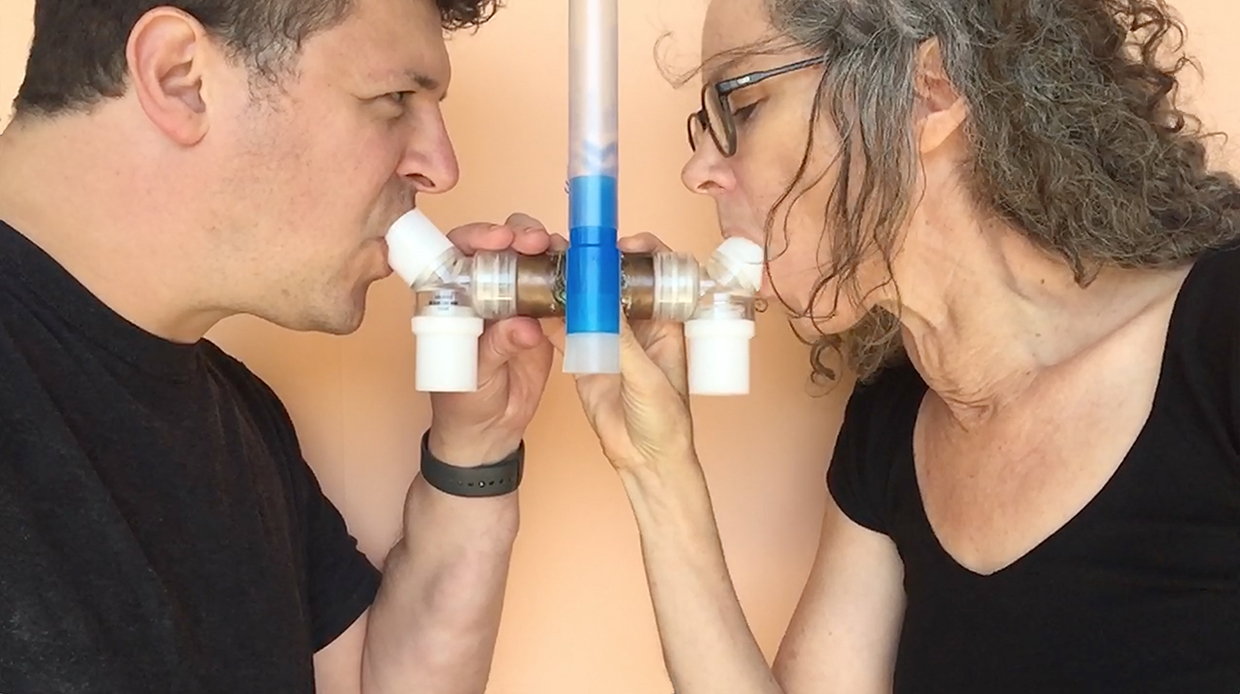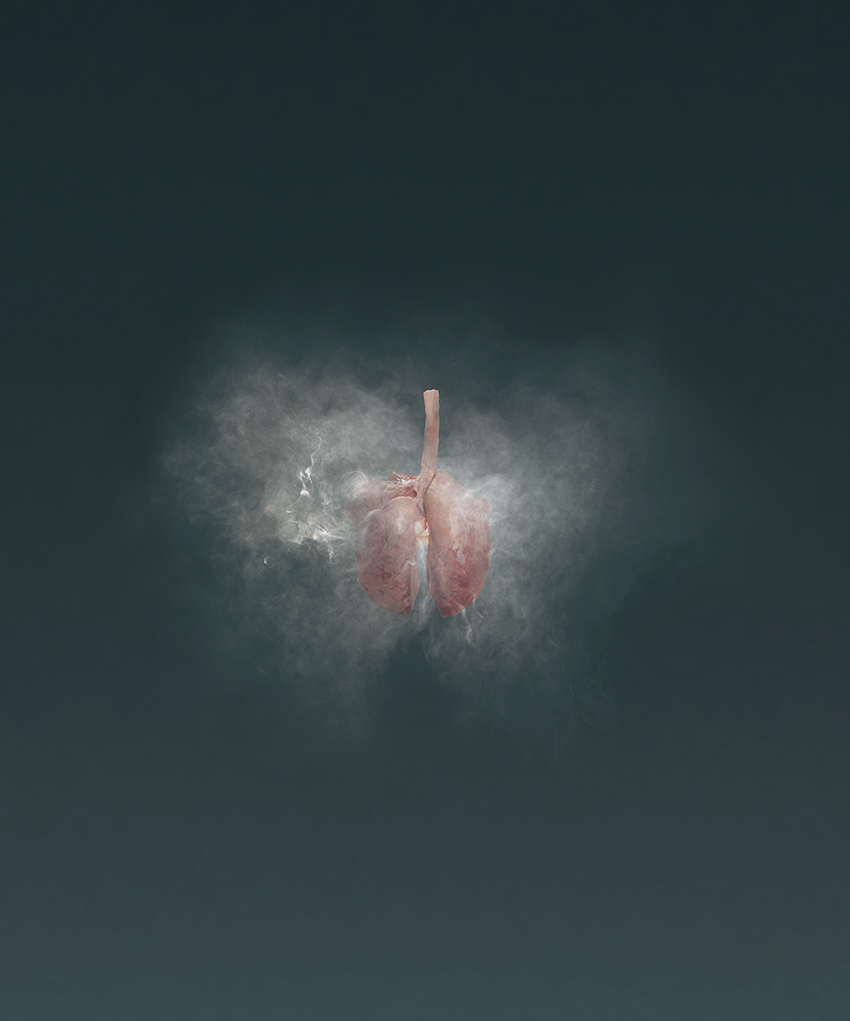2020-21 ANAT SAHMRI Bespoke Residency

Dr Helen Pynor and Dr Jimmy Breen, documentation, testing the collection of a shared breath sample using the R-tube device. Exhaled DNA will later be extracted and sequenced. 2021. Image courtesy of the artist. ANAT SAHMRI residency, Adelaide, 2021.
Since 2020 ANAT SAHMRI resident Dr Helen Pynor has been undertaking collaborative research with Dr Jimmy Breen, leader of the SAHMRI Bioinformatics Platform. Helen and Jimmy are exploring ideas around the liminality of DNA once it leaves its originating body.
Helen says “my broad goal in this residency was to ‘denature’ DNA by asking: How does DNA exceed the spatial, material, temporal and ethical bounds we place around it in our habitual understandings? How does DNA go rogue? When is DNA ‘out-of-place’?”
Helen says “I was aware that we shed DNA that’s in our skin cells, as we go about our daily lives, but was fascinated to learn from Jimmy that we breathe out our own DNA in the vapour that comes out of our lungs – our exhalations. It’s fascinating to me that this molecule, DNA, that we regard as central to our biological identity and is tucked away securely inside cell nuclei, is casually emitted by us each time we exhale. And that we are, of course, also inhaling the DNA of others, that similarly floats on the airwaves of others’ exhalations. There’s something humorously promiscuous about this unseen and unexpected exchange of DNA material. But it’s also materially and philosophically intriguing – it speaks to our bodily porosity, our everyday exchanges with the world on a moment to moment basis, and DNA’s capacity to exceed our expectations in its wanderings and somewhat self-directed exchanges. It also has resonances with the COVID world we’re living in and the now familiar phenomenon of viral shedding.”
Helen and Jimmy have been conducting an experiment to collect and analyse a shared breath sample of their own breath. They have extracted and sequenced the DNA from this sample in Jimmy’s lab at SAHMRI, the SAGC (South Australian Genomics Centre). The sample revealed 93% human DNA and the remaining DNA from a rich and diverse combination of species, most likely from Helen and Jimmy’s respiratory microbiomes. Helen says “The result speaks to both the wandering nature of DNA, and our multispecies nature. With the various microbiomes that live with us, on which our very health depends, we are only ever ‘93% Human.” This is the working title of the artwork Helen is developing out of the residency research: a performance video of Helen and Jimmy breathing into the R-tube breath collection device (pictured above), a conceptual treatment of the DNA sequence data generated from the experiment, and a kinetic haptic sculpture that produces steam and air currents.
The image below is a metaphoric visualization of the porosity of lungs, and the manner in which our lungs (and our bodies more broadly) diffuse out in the world, and are in constant exchange with the world. “In the case of this project”, Helen says “the exploration is about breath and the exchanges of DNA. The way breath symbolizes, and literally enacts materially, the exchanges taking place between our interior bodies and the world. So the notion of a hard boundary between our interior bodies and the world is illusory.”

Breathwork, Helen Pynor, 2021, archival pigment print, 120 x 100 cm, edition of 5 + 1AP. Image courtesy of the artist.
In another aspect of the residency research Helen and Jimmy have been in dialogue with Dr Carolyn Johnston, legal scholar and bioethicist from The University of Tasmania. Carolyn has acted as an academic advisor on questions around the ownership and governance of DNA once it leaves its originating body, particularly in the context of DNA that is sample for clinical, research and ancestry purposes.
As part of her residency Helen is compiling a dedicated creative research blog, documenting her research and artmaking process as it develops.
Read Helen’s CREATIVE RESEARCH JOURNAL here
The inaugural 2020 ANAT SAHMRI Bespoke residency is an opportunity for an artist to engage with issues around the ownership and governance of DNA material. In particular, the residency facilitates interdisciplinary knowledge generation focused on the myriad ethical, philosophical, legislative and other frameworks that inform the status of DNA material once it leaves its originating body.
Media Links
The Lead, 17 May 2021 by Georgia Honan
Art and Science collaborate in new DNA research
Radio Adelaide’s Dr Naomi Hunter in conversation with Dr Helen Pynor and Dr Jimmy Bream
Dr Helen Pynor is an Artist and Researcher whose practice explores philosophically and experientially ambiguous zones, such as the life-death boundary. Her work is informed by in-depth residencies in scientific and clinical institutions, where she redeploys scientific methodologies and technologies in the service of ontological inquiries.
Her work is informed by in-depth residencies in scientific and clinical institutions, for example The Francis Crick Institute, London; The Max Planck Institute of Molecular Cell Biology and Genetics, Dresden; The Heart and Lung Transplant Unit, St Vincent’s Hospital, Sydney; and SymbioticA, The University of Western Australia, Perth; and cultural institutions for example The Australia Council for the Arts London Studio; Performance Space, Sydney; andÉcole Nationale Supérieure des Beaux-Arts, Paris. Helen also frequently collaborates with members of the broader community whose embodied experiences connect with the themes of her work.
Dr Jimmy Breen, is leader of the SAHMRI Bioinformatics Platform. Jimmy’s group develops computational tools to enable the analysis of large, complex genomics datasets. Dr Breen’s current research interests include developing methods for clinical cancer sequencing (in collaboration with the SAHMRI Leukaemia research group) and investigating epigenomic gene regulation in human reproductive tissues, such as the Placenta.
Dr Carolyn Johnston is an academic lawyer, working as Research Fellow at University of Tasmania as well as a Clinical Ethicist at Monash Children’s Hospital. Carolyn taught health law and ethics to medical and law students and to healthcare professionals. Whilst at King’s College London (2004 – 2017) she made short films with medical students to highlight ethical issues in clinical practice. At University of Melbourne (2017- 2020) Carolyn taught health law on a range of undergrad and Masters’ programs including Health Law, Ethics and Society, Emerging Technologies in Healthcare and Genomics and Health. Carolyn’s publications in the field of health law and ethics focus on end-of-life decision making and digital health technologies.
BACKGROUND
In 2020, ANAT announced a new art + science residency in partnership with the South Australian Health and Medical Research Institute (SAHMRI), with additional research support from Health, Law and Emerging Technologies at the University of Melbourne.
The ANAT SAHMRI Bespoke residency provides an opportunity for an artist to engage with issues around the ownership and governance of DNA material. In particular, the residency will facilitate interdisciplinary knowledge generation focused on the myriad ethical, philosophical, legislative and other frameworks that inform the status of DNA material once it leaves its originating body.
PROJECT PARTNERS
ANAT
ANAT is a global leader in brokering opportunities for artists to work with science and technology partners. We do this because we believe artists are essential to how we imagine and shape our future.
South Australian Health and Medical Research Institute (SAHMRI)
SAHRMI is South Australia’s flagship health and medical research institute. SAHMRI’s vision is to create and deliver evidence-based, optimised, precision health care solutions for all Australians, across their life course, with a particular focus on greater living.
Health, Law and Emerging Technologies, University of Melbourne (HeLEX@Melbourne)
HeLEX@Melbourne was established at the University of Melbourne’s Law School in 2017 in order to progress research into the legal and regulatory frameworks for new health technologies, including genomics, stem cell research, gene editing and digital health.